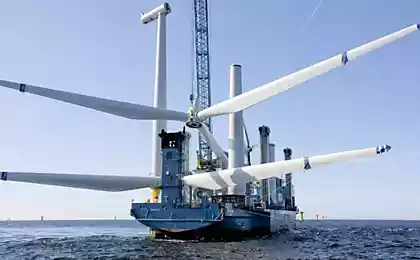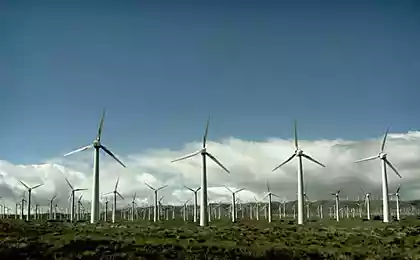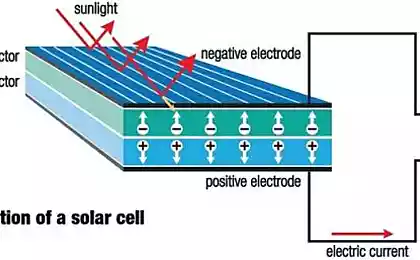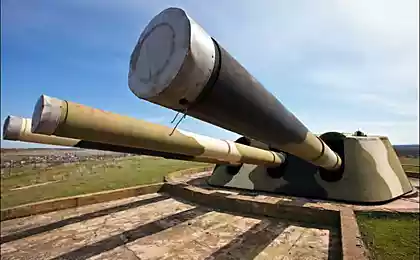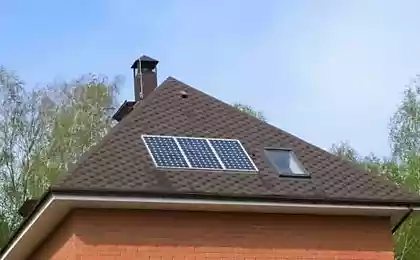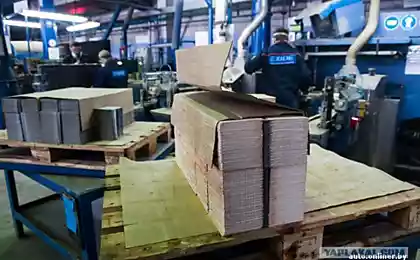551
The use of EDLC supercapacitors in renewable energy. World practice
The use of supercapacitors double layer (Electric Double Layer Capacitor) in a technologically developed world is growing steadily. If in 2011 the market volume was just over $ 550 million in the current year the volume of consumption of supercapacitors to exceed $ 2 billion, and by 2025 will amount to $ 8 billion (Fig. 1). This is because the use of supercapacitors in many cases allows you to implement a more efficient, environmentally friendly and economically sound decisions, and in some cases, go on a fundamentally new technical and technological level. The distinctive features of supercapacitors include:
1. High power density, which makes supercapacitors ideal way to work with a sharp and significant changes in capacity and effective use for stabilization of current parameters.
2. High speed charge/discharge, enabling effective use of supercapacitors in systems of energy recovery and compensation of impulse power.
3. Wide operating temperature range from -40 to 65 °C, which ensures their application in various systems for street performance without special climate control systems.
4. Service life not less than 10 years (million cycles of charge/discharge), eliminating the need for frequent replacements and reduces maintenance costs.
5. Integrity and sustainability, which eliminates the necessity of operating costs and expenses for the implementation of environmental activities.
6. Compactness, small dimensions and weight, which makes supercapacitors efficient for stand-alone and mobile applications.

The use of supercapacitors in many cases allows you to implement a more efficient, environmentally friendly and economically sound decisions, and in some cases, go on a fundamentally new technical and technological level
The main consumers of supercapacitors in the world are European countries, USA and Asian countries such as China, Japan and South Korea.
The main producers of supercapacitors are the following companies: Maxwell Technologies (USA), Panasonic, NEC-Tokin, Cooper Electronic Technologies, Seiko Instruments, Nippon-Chemi-Con (Japan), Nesscap (Korea), which account for 70 % of the market (Fig. 2).
Supercapacitors are currently used in almost all industries, however, the main customers include manufacturers of electronics, transportation, energy including renewable, and power equipment (Fig. 3).
The use of ultracapacitors in renewable energy is important due to its initial instability, especially if we are talking about wind generators or solar batteries. To ensure the required end-users the quality and stability of volume they generate electricity and integrate renewable energy sources into a single distribution network, it is required to carry out costly activities, and in this case, the application of supercapacitors is becoming an effective alternative to traditional solutions.
In the world practice in renewable energy supercapacitors are used in the following areas (table. 1).
One of the most common applications of supercapacitors is their use in the systems of control orientation (rotation) of the rotor blades of wind turbines to ensure maximum power generation and prevent breakage of the blades at high wind speeds, the so-called Pitch control system (Fig. 4).
To date, there are hydraulic and electrical systems, the latter have been increasingly used because of their environmental friendliness and lower operating costs. Currently, about 30% of wind turbines in the world are equipped with supercapacitors, which provide the desired turning of the blades pulsed power, stabilization parameters and the maintenance of power to the short-term voltage failures as well as safe and correct the orientation of the blades.

Supercapacitors are currently used in almost all industries, however, the main customers include manufacturers of electronics, transport, energy, including renewable energy, and power equipment
Share applications of supercapacitors in systems control Pitch is constantly growing, primarily due to the refusal of the batteries due to the fact that the use of ultracapacitors is more reliable and more economical (Fig. 5).
To date, the development of the use of supercapacitors for wind turbines reached the stage of the formation of industry standards supercondensators drives (Fig. 6).
Another common application is the use of supercapacitors in the "hybrid" energy storage systems in conjunction with batteries. In these systems, supercapacitors and rechargeable batteries offset the disadvantages each other. Rechargeable batteries are used as a primary store of energy, while supercapacitors deliver the pulse modes, compensating for the volatile generation of renewable energy and rapid changes in load (Fig. 6). In addition, the supercapacitors to protect batteries from voltage lags, and high-current charge/ discharge. The need for batteries may be reduced five times, and the battery life increased up to two times.
The hybrid system energy storage in many cases are the most effective solution to the integration of renewable energy sources in the distribution network, compensation, pulsed power loads, energy recovery, etc., which there is already plenty of practical evidence.

One of the largest U.S. energy companies Duke Energy was faced with the need to incur significant costs associated with upgrading existing infrastructure when connecting renewable energy sources to the distribution network. With the aim of smoothing unstable of solar power generation, pulse power compensation and maintain the load during periods of low generation was installed a hybrid drive composed of supercapacitors 277 kWh 8,0 kWh battery and 50 kW / 300 kWh. Supercapacitors compensate for how quickly changes power solar generation, and pulse load, thereby eliminating batteries from degrading their modes of charge/discharge. Batteries provide a long-term accumulation of energy from the solar panels and maintaining the load in the most optimal for this period of time. The result: reduced capital expenditures by 10-15% and reduction of operational costs by 30 % compared to using only batteries.
Another example of the effective use of "hybrid" energy storage systems can serve the project of the Southeastern Pennsylvania Transportation Authority (SEPTA). More than 80% of consumed by this project 500 GW of energy is necessary to ensure movement by rail. Recuperation of braking energy could lead to substantial savings in electricity consumption. Respectively, were developed and installed a "hybrid" energy storage system "supercapacitor" battery, designed to perform the following main functions:
1. Recuperation of braking energy. Supercapacitors store energy braking, determining the increase of voltage in the contact network. This process occurs several thousand times a day and lasts about 15-20 seconds.
2. The modulation of the load to provide frequency regulation in the energy market. An average of 90 minutes per day is spent on the process of recovery of braking energy, respectively, while the rest is used to implement this function.
As a result, achieved 20 % reduction in energy consumption from the network, and 800 kW modulation of the capacity with quick connect. Since this is a paid service provided by the energy system operator, this function brings the SEPTA more than $ 200 thousand of revenue annually.
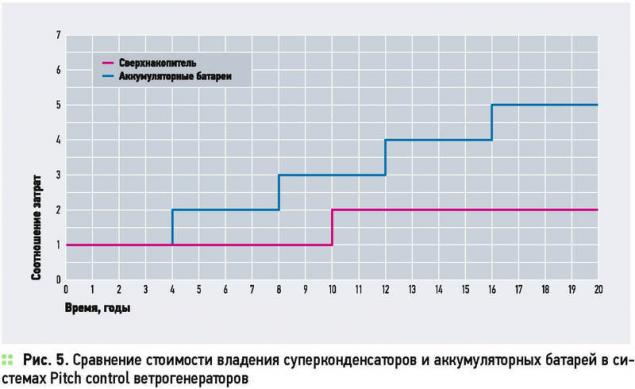
Confirmed research and practice, the effectiveness of the application of ultracapacitors for off-grid power, where the main or only sources of energy are renewable sources or diesel generators
As an example effective solutions compensation pulse power using supercapacitors can be the project of Yangshan deep-water port in China, located near Shanghai. 23 port crane constantly created significant changes (drawdown) voltage with a duration of 10-15 seconds. Because the port is 20 miles from the coast, the increase in input power and laying of additional power cables were very expensive. As alternative solutions were developed and installed supercondensators drive 3 MW / 17,2 kWh, providing a 20-second support and compensation of the voltage drop during operation of cranes. To date, the system is operated for more than two years. The result: 38% reduction in the consumption of electricity in peak mode, the energy savings amounted to $ 2.9 million, and savings by increasing efficiency and reducing operating costs totaled $ 41 million.
Also of note is confirmed by research and practice, the effectiveness of the application of ultracapacitors for off-grid power, where the main or only sources of energy are renewable sources or diesel generators. First of all we are talking about individual households and villages where there is no electricity, but it's not just them. As an example, the road infrastructure, which is especially important for Russia, where the roads are large and the supply is missing.
Autonomous system it makes sense to use in cases where the main sources of electric power are so far removed from the road and equipment road infrastructure, laying of cable networks to power the load goes relatively more expensive when there is a need for temporary supply of electricity, for example, in cases of construction and repair of roads and when necessary to ensure a long service life (10 years) in standalone mode in a wide temperature range (-40 to +65 °C) without the need for frequent maintenance and replacements.
The supercapacitors used independently or as part of hybrid energy storage systems are an effective solution when building Autonomous power supply systems of gas stations, points of collection of fees for toll roads, road emergency telephone, parmname, surveillance cameras, communication systems and data transmission. The use of solar batteries in conjunction with supercapacitors as energy storage allows you to effectively organize road lighting and markings, lighting, road signs, etc.

Insights
Supercapacitors are one of the three basic elements — drives/ energy and take on its characteristics, intermediate between capacitors and batteries. Due to the unique properties, the consumption of ultracapacitors in the world are constantly increasing. Currently, supercapacitors are used in virtually all sectors of the global industry, and renewable energy is no exception (tab. 2).
Conducted research and practical international experience shows that in most cases the use of supercapacitors in all stages, from the generation of electricity from renewable energy sources to final consumers, is the most effective solution from a technical point of view, and total cost of ownership and environmental friendliness.
Russian state program of energy saving and energy efficiency for the period till 2020, providing the production of electricity from renewable energy sources by 2020 at the level of 4.5 % (of the total electricity production in 2020), which involves generating capacities based on renewable energy sources, infrastructure for their connection to distribution networks, storage systems, storage and transmission of electricity, etc.
It would be useful to the developers and creators of these decisions took into account the existing international experience and considered the application of supercapacitors as one of the alternatives, which in many cases may be the most effective solution.

published
Source: www.c-o-k.ru/articles/primenenie-superkondensatorov-edlc-v-vozobnovlyaemoy-energetike-mirovaya-praktika
1. High power density, which makes supercapacitors ideal way to work with a sharp and significant changes in capacity and effective use for stabilization of current parameters.
2. High speed charge/discharge, enabling effective use of supercapacitors in systems of energy recovery and compensation of impulse power.
3. Wide operating temperature range from -40 to 65 °C, which ensures their application in various systems for street performance without special climate control systems.
4. Service life not less than 10 years (million cycles of charge/discharge), eliminating the need for frequent replacements and reduces maintenance costs.
5. Integrity and sustainability, which eliminates the necessity of operating costs and expenses for the implementation of environmental activities.
6. Compactness, small dimensions and weight, which makes supercapacitors efficient for stand-alone and mobile applications.

The use of supercapacitors in many cases allows you to implement a more efficient, environmentally friendly and economically sound decisions, and in some cases, go on a fundamentally new technical and technological level
The main consumers of supercapacitors in the world are European countries, USA and Asian countries such as China, Japan and South Korea.
The main producers of supercapacitors are the following companies: Maxwell Technologies (USA), Panasonic, NEC-Tokin, Cooper Electronic Technologies, Seiko Instruments, Nippon-Chemi-Con (Japan), Nesscap (Korea), which account for 70 % of the market (Fig. 2).
Supercapacitors are currently used in almost all industries, however, the main customers include manufacturers of electronics, transportation, energy including renewable, and power equipment (Fig. 3).
The use of ultracapacitors in renewable energy is important due to its initial instability, especially if we are talking about wind generators or solar batteries. To ensure the required end-users the quality and stability of volume they generate electricity and integrate renewable energy sources into a single distribution network, it is required to carry out costly activities, and in this case, the application of supercapacitors is becoming an effective alternative to traditional solutions.
In the world practice in renewable energy supercapacitors are used in the following areas (table. 1).
One of the most common applications of supercapacitors is their use in the systems of control orientation (rotation) of the rotor blades of wind turbines to ensure maximum power generation and prevent breakage of the blades at high wind speeds, the so-called Pitch control system (Fig. 4).
To date, there are hydraulic and electrical systems, the latter have been increasingly used because of their environmental friendliness and lower operating costs. Currently, about 30% of wind turbines in the world are equipped with supercapacitors, which provide the desired turning of the blades pulsed power, stabilization parameters and the maintenance of power to the short-term voltage failures as well as safe and correct the orientation of the blades.

Supercapacitors are currently used in almost all industries, however, the main customers include manufacturers of electronics, transport, energy, including renewable energy, and power equipment
Share applications of supercapacitors in systems control Pitch is constantly growing, primarily due to the refusal of the batteries due to the fact that the use of ultracapacitors is more reliable and more economical (Fig. 5).
To date, the development of the use of supercapacitors for wind turbines reached the stage of the formation of industry standards supercondensators drives (Fig. 6).
Another common application is the use of supercapacitors in the "hybrid" energy storage systems in conjunction with batteries. In these systems, supercapacitors and rechargeable batteries offset the disadvantages each other. Rechargeable batteries are used as a primary store of energy, while supercapacitors deliver the pulse modes, compensating for the volatile generation of renewable energy and rapid changes in load (Fig. 6). In addition, the supercapacitors to protect batteries from voltage lags, and high-current charge/ discharge. The need for batteries may be reduced five times, and the battery life increased up to two times.
The hybrid system energy storage in many cases are the most effective solution to the integration of renewable energy sources in the distribution network, compensation, pulsed power loads, energy recovery, etc., which there is already plenty of practical evidence.

One of the largest U.S. energy companies Duke Energy was faced with the need to incur significant costs associated with upgrading existing infrastructure when connecting renewable energy sources to the distribution network. With the aim of smoothing unstable of solar power generation, pulse power compensation and maintain the load during periods of low generation was installed a hybrid drive composed of supercapacitors 277 kWh 8,0 kWh battery and 50 kW / 300 kWh. Supercapacitors compensate for how quickly changes power solar generation, and pulse load, thereby eliminating batteries from degrading their modes of charge/discharge. Batteries provide a long-term accumulation of energy from the solar panels and maintaining the load in the most optimal for this period of time. The result: reduced capital expenditures by 10-15% and reduction of operational costs by 30 % compared to using only batteries.
Another example of the effective use of "hybrid" energy storage systems can serve the project of the Southeastern Pennsylvania Transportation Authority (SEPTA). More than 80% of consumed by this project 500 GW of energy is necessary to ensure movement by rail. Recuperation of braking energy could lead to substantial savings in electricity consumption. Respectively, were developed and installed a "hybrid" energy storage system "supercapacitor" battery, designed to perform the following main functions:
1. Recuperation of braking energy. Supercapacitors store energy braking, determining the increase of voltage in the contact network. This process occurs several thousand times a day and lasts about 15-20 seconds.
2. The modulation of the load to provide frequency regulation in the energy market. An average of 90 minutes per day is spent on the process of recovery of braking energy, respectively, while the rest is used to implement this function.
As a result, achieved 20 % reduction in energy consumption from the network, and 800 kW modulation of the capacity with quick connect. Since this is a paid service provided by the energy system operator, this function brings the SEPTA more than $ 200 thousand of revenue annually.

Confirmed research and practice, the effectiveness of the application of ultracapacitors for off-grid power, where the main or only sources of energy are renewable sources or diesel generators
As an example effective solutions compensation pulse power using supercapacitors can be the project of Yangshan deep-water port in China, located near Shanghai. 23 port crane constantly created significant changes (drawdown) voltage with a duration of 10-15 seconds. Because the port is 20 miles from the coast, the increase in input power and laying of additional power cables were very expensive. As alternative solutions were developed and installed supercondensators drive 3 MW / 17,2 kWh, providing a 20-second support and compensation of the voltage drop during operation of cranes. To date, the system is operated for more than two years. The result: 38% reduction in the consumption of electricity in peak mode, the energy savings amounted to $ 2.9 million, and savings by increasing efficiency and reducing operating costs totaled $ 41 million.
Also of note is confirmed by research and practice, the effectiveness of the application of ultracapacitors for off-grid power, where the main or only sources of energy are renewable sources or diesel generators. First of all we are talking about individual households and villages where there is no electricity, but it's not just them. As an example, the road infrastructure, which is especially important for Russia, where the roads are large and the supply is missing.
Autonomous system it makes sense to use in cases where the main sources of electric power are so far removed from the road and equipment road infrastructure, laying of cable networks to power the load goes relatively more expensive when there is a need for temporary supply of electricity, for example, in cases of construction and repair of roads and when necessary to ensure a long service life (10 years) in standalone mode in a wide temperature range (-40 to +65 °C) without the need for frequent maintenance and replacements.
The supercapacitors used independently or as part of hybrid energy storage systems are an effective solution when building Autonomous power supply systems of gas stations, points of collection of fees for toll roads, road emergency telephone, parmname, surveillance cameras, communication systems and data transmission. The use of solar batteries in conjunction with supercapacitors as energy storage allows you to effectively organize road lighting and markings, lighting, road signs, etc.

Insights
Supercapacitors are one of the three basic elements — drives/ energy and take on its characteristics, intermediate between capacitors and batteries. Due to the unique properties, the consumption of ultracapacitors in the world are constantly increasing. Currently, supercapacitors are used in virtually all sectors of the global industry, and renewable energy is no exception (tab. 2).
Conducted research and practical international experience shows that in most cases the use of supercapacitors in all stages, from the generation of electricity from renewable energy sources to final consumers, is the most effective solution from a technical point of view, and total cost of ownership and environmental friendliness.
Russian state program of energy saving and energy efficiency for the period till 2020, providing the production of electricity from renewable energy sources by 2020 at the level of 4.5 % (of the total electricity production in 2020), which involves generating capacities based on renewable energy sources, infrastructure for their connection to distribution networks, storage systems, storage and transmission of electricity, etc.
It would be useful to the developers and creators of these decisions took into account the existing international experience and considered the application of supercapacitors as one of the alternatives, which in many cases may be the most effective solution.

published
Source: www.c-o-k.ru/articles/primenenie-superkondensatorov-edlc-v-vozobnovlyaemoy-energetike-mirovaya-praktika
